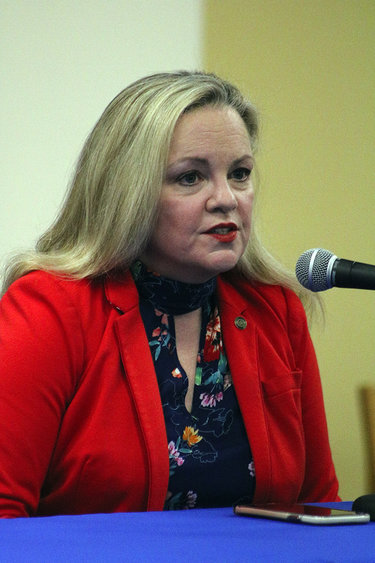As another county resident dies of COVID-19, confirmed case counts have not declined
ALBANY COUNTY — As testing in the county continues without a decline in confirmed COVID-19 cases, another resident has died of the disease, bringing the county’s death toll to 31.
The most recent county victim of coronavirus disease 2019 was a man in his sixties with underlying health conditions. A resident of the county’s nursing home, Shaker Place, he died yesterday at St. Peter’s Hospital in Albany.
In making the announcement at his Friday press briefing, County Executive Daniel McCoy thanked the staff at the nursing home for their work and said, “It’s hard on everybody as well as the families.”
So far, 33 Shaker Place residents have tested positive for COVID-19 as have 14 employees; one of those employees has recovered and returned to work.
“We’ve been very aggressive,” said McCoy, of testing both Shaker Place residents and workers. He noted the county had forbidden visitors to Shaker Place before Governor Andrew Cuomo had made a similar statewide executive order.
Countywide, 784 residents have tested positive for COVID-19 while 753 are under mandatory quarantine and 54 are under precautionary quarantine.
Altogether, 1,902 county residents have completed quarantine and 431 of those who tested positive for COVID-19 have recovered.
Currently, 30 Albany County residents are hospitalized with the disease, with seven in intensive-care units. The county’s hospitalization rate stands at 3.83 percent of those who have tested positive for the disease.
In addition to the state-run drive-through testing facility at the uptown University at Albany campus, the county, working with the federal health department and Rite Aid has set up a drive-through site in Colonie.
Also, the county, working with the Whitney M. Young Health Center, has set up four walk-in mobile test sites in high-risk neighborhoods in which 370 people have been tested so far.
McCoy reported on Thursday that 187 of the people tested at the walk-in sites were African American, 151 were white, 9 were Asians, 5 were American Indians, 3 were Pacific Islanders, 4 were of more than one race, and the rest did not disclose their race on the questionnaire.
Of the 257 returned test results, 17, or 7 percent, came back positive, McCoy said.
He noted that the Centers for Disease Control and Prevention “is talking about a second wave in October worse than what we’re going through now and we’re not even through what we’re going through.”
McCoy also said, “Our numbers are going to steadily climb more than anywhere else because of the testing we’re doing.”
“We’re still getting 20 to 30 positives a day,” said Albany County’s health commissioner, Elizabeth Whalen. “We’re still at that plateau level.”
However, Whalen also said that, over the last day or so, fewer people were tested. Typically, 300 county residents are tested daily but yesterday only about 150 were tested. It is too soon to tell, she said, if that is “a blip or a downward trend.”
The maps and graphs tracking COVID-19 testing, which the county started displaying on its website this week, have been well received, Whalen said. She hopes by next week to be able to display “more granular information,” she said, including demographics related to those who have been hospitalized and those who have been in intensive-care units as well as death data.
Whalen said of the county’s 31 COVID-19 deaths, seven, or 22 percent, have been African Americans. About 11.4 percent of the roughly 320,000 residents of Albany County are African Americans.
“Good news and bad news”
Whalen also spoke about the antibody test results — sampling 3,000 New Yorkers — released yesterday by Governor Cuomo. While 13.9 percent of New Yorkers tested positive, Whalen noted that the percentage upstate was 3.6 percent, compared to the rate for New York City residents of over 21 percent.
“They sought … to test people that had not been diagnosed,” Whalen explained “to gain information on people who had it that may have been asymptomatic.”
Whalen went on, “So this is good news and bad news. The good news is this low result means a lot of what we’re doing with the social distancing and staying home is working. The bad news is what this infers to us is that the vast majority of [upstate] residents are still not immune to COVID-19 and are therefore still susceptible to it.
“This makes it all the more important for us to be conscientious about the work we’re doing about infection control, about meticulous hand hygiene, having masks, and ensuring we are doing our best to prevent spread in our community.”
Such practices, she said, will need to continue until there is a significant amount of immunity in the public or until there is a vaccine. A vaccine, Whalen said, is at least another 12 months out.
Whalen also stressed the importance of wearing a mask when it’s not possible to stay at least six feet from others.
“When you wear a surgical mask or homemade face-covering, what you’re really doing is protecting others from germs you may be carrying,” she said. “People that say, ‘I’m not worried about COVID,’ please realize that you’re putting this on for other people. It is protecting other people from your germs.”
Whalen concluded, “What we’re doing is working. We need to wait for more information to determine how we can roll out getting back to some semblance of re-opening to the community … The numbers and evidence and science have to be our guide going forward.”


